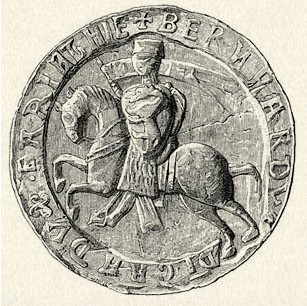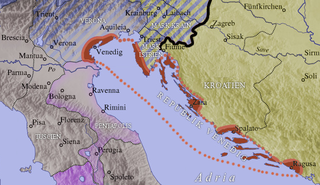Related Research Articles

The Duchy of Carinthia was a duchy located in southern Austria and parts of northern Slovenia. It was separated from the Duchy of Bavaria in 976, and was the first newly created Imperial State after the original German stem duchies.
Henry IV was Duke of Carinthia and Margrave of Verona from 1122 until his death. He was the first ruler of those territories from the Rhenish House of Sponheim.

The Marchof Carniola was a southeastern state of the Holy Roman Empire in the High Middle Ages, the predecessor of the Duchy of Carniola. It corresponded roughly to the central Carniolan region of present-day Slovenia. At the time of its creation, the march served as a frontier defense against the Kingdoms of Hungary and Croatia.

The March of Verona and Aquileia was a vast march of the Holy Roman Empire in the northeastern Italian Peninsula during the Middle Ages, centered on the cities of Verona and Aquileia. Seized by King Otto I of Germany in 952, it was held by the Dukes of Bavaria; from 976 in personal union with the Duchy of Carinthia. The margravial regime ended with the advent of the Lombard League in 1167.

Bernhard von Spanheim, a member of the noble House of Sponheim, was Duke of Carinthia for 54 years from 1202 until his death. A patron of chivalry and minnesang, Bernhard's reign marked the emergence of the Carinthian duchy as an effective territorial principality.

The March of Istria was originally a Carolingian frontier march covering the Istrian peninsula and surrounding territory conquered by Charlemagne's son Pepin of Italy in 789. After 1364, it was the Istrian province of the Habsburg monarchy, the Austrian Empire and Austria-Hungary.
Poppo I, Count of Weimar-Orlamünde, was margrave of Istria from 1012 and of Carniola from 1040 to his death.
Ulric I, also Odalric or Udalrich, Count of Weimar-Orlamünde, was margrave of Carniola from 1045 and of Istria from 1060 to his death.
Poppo II, Count of Weimar-Orlamünde, was margrave of Carniola from 1070 and of Istria from 1096 to his death.
Ulric II was the Margrave of Istria from 1098 until circa 1107 and Carniola from 1098 until his death. He was the second son of Ulric I and Sophia, a daughter of Bela I of Hungary. He was thus of royal blood.
The House of Sponheim or Spanheim was a medieval German noble family, which originated in Rhenish Franconia. They were immediate Counts of Sponheim until 1437 and Dukes of Carinthia from 1122 until 1269. Its cadet branches ruled in the Imperial County of Ortenburg-Neuortenburg and various Sayn-Wittgenstein states until 1806.
Engelbert III, a member of the Rhenish Franconian House of Sponheim, was Margrave of Istria from 1124 until his death.

The House of Andechs was a feudal line of German princes in the 12th and 13th centuries. The counts of Dießen-Andechs obtained territories in northern Dalmatia on the Adriatic seacoast, where they became Margraves of Istria and ultimately dukes of a short-lived imperial state named Merania from 1180 to 1248. They were also self-styled lords of Carniola.

Berthold III, a member of the Bavarian House of Andechs, was Margrave of Istria from 1173 until his death.
Herman II of Spanheim, a scion of the Rhenish House of Sponheim, was Duke of Carinthia from 1161 until his death.
Siegfried I is considered the progenitor of the Carinthian ducal House of Sponheim (Spanheimer) and all of its lateral branches, including the Counts of Lebenau and the Counts of Ortenburg. He is documented as Count of Sponheim from 1044 and served as margrave of the Hungarian March in 1045/46 and as count in the Puster Valley and the Lavant Valley from 1048 until his death.
Sophia of Hungary, a member of the royal Árpád dynasty, was a Margravine of Istria and Carniola from about 1062 until 1070, by her first marriage with Margrave Ulric I, as well as Duchess of Saxony from 1072 until her death, by her second marriage with Duke Magnus Billung.
Ulrich I, of the House of Sponheim, was the Duke of Carinthia and Margrave of Verona from 1135 until his death. He was the eldest son of Duke Engelbert and Uta, daughter of Burggrave Ulrich of Passau, his namesake. His father abdicated in 1135 and Ulrich was appointed his successor by the Emperor Lothair II at an imperial diet being held in Bamberg.
Engelbert I was Margrave of Istria (1090–1096), Count of Sponheim, Kraichgau, and Pustertal and Vogt of the Archbishopric of Salzburg. As a supporter of Pope Gregory VII during the Investiture Controversy, he lost the county of Pustertal. In 1091, Engelbert founded the Benedictine monastery of St. Paul. He retired as a monk there in 1095 and died in 1096.
References
- 1 2 3 4 Schenk 2017, p. xiv.
- ↑ Lyon 2007, p. 147.
- ↑ Loibl 1997, p. 160.
- 1 2 Bouchard 1987, p. 347.